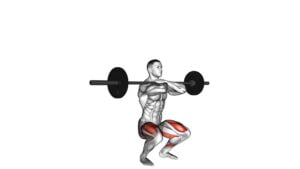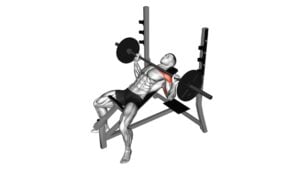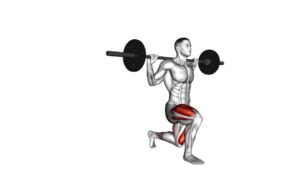Barbell Pause Deadlift – Video Exercise Guide & Tips

Are you looking to strengthen your lower body and improve your deadlift technique?
Watch This Exercise Video
Then the Barbell Pause Deadlift is the exercise for you. In this video exercise guide, we'll show you the proper set-up, execution, and technique tips to make the most out of this challenging exercise.
Avoid common mistakes and learn variations and progressions to take your deadlifts to the next level.
Get ready to incorporate the Barbell Pause Deadlift into your workout routine and see impressive results.
Key Takeaways
- Barbell Pause Deadlift enhances overall strength and power.
- It targets specific muscle groups effectively and activates the posterior chain.
- The exercise improves explosive power and strength, as well as strength off the floor.
- It also enhances grip strength and muscle activation.
Benefits of the Barbell Pause Deadlift
Experience significant gains in strength and muscle development with the barbell pause deadlift. This variation of the deadlift exercise focuses on enhancing your overall strength and power by incorporating pause deadlifts into your routine. The barbell pause deadlift technique involves pausing momentarily at the mid-shin position during the lift. This pause forces your muscles to work harder to initiate the lift, increasing the time under tension and intensifying the exercise.
By incorporating pause deadlifts into your training regimen, you can target specific muscle groups more effectively. The pause at the mid-shin position activates your posterior chain, including your glutes, hamstrings, and lower back, allowing for greater muscle activation and development. This exercise is particularly beneficial for athletes seeking to improve their explosive power and strength, as it simulates the initial phase of a vertical jump or a sprint start.
Furthermore, the barbell pause deadlift helps improve your overall lifting technique. The pause allows you to maintain proper form and posture throughout the lift, reinforcing proper hip and spine alignment. This, in turn, reduces the risk of injury and enhances your overall performance in other compound lifts.
Now that you understand the benefits of the barbell pause deadlift, let's move on to the next section, which will cover proper set-up and grip position for optimal execution of the exercise.
Proper Set-Up and Grip Position
To properly execute the barbell pause deadlift, ensure that you have the correct set-up and grip position. The proper set-up is crucial for maximizing your performance and reducing the risk of injury. Begin by standing with your feet shoulder-width apart and the barbell positioned on the floor in front of you.
To determine the optimal grip position, place your hands just outside your legs, ensuring that your arms are fully extended. Your grip should be firm but not excessively tight, allowing for a comfortable and secure hold on the barbell.
Once you have established the proper set-up and grip position, you're ready to move on to the execution and technique tips. By following these guidelines, you'll be able to perform the barbell pause deadlift with confidence and achieve the desired benefits for your strength and muscle development.
Now that you have the correct set-up and grip position, it's time to focus on the execution and technique tips that will help you perform the barbell pause deadlift effectively.
Execution and Technique Tips
Focus on maintaining proper form and activating your target muscles while performing the barbell pause deadlift. Follow these execution and technique tips to maximize the benefits of this exercise:
- Start with your feet hip-width apart and toes slightly turned out. Position the barbell over your midfoot.
- Bend at the hips and knees, keeping your back straight and chest up. Grip the barbell with an overhand grip, hands shoulder-width apart.
- Engage your core and lats as you lift the barbell off the floor. Keep the barbell close to your body throughout the movement.
- Pause for a few seconds at the top of the lift, squeezing your glutes and maintaining a neutral spine.
These cues will help you perform the barbell pause deadlift with proper form, ensuring that you activate the target muscles effectively.
The benefits of this exercise include increased strength and power in your posterior chain, improved grip strength, and enhanced hip mobility. By incorporating the pauses at the top of the lift, you also challenge your muscles to maintain tension, leading to greater muscle activation and development.
Remember to start with lighter weights and gradually increase the load as your technique improves.
Common Mistakes to Avoid
To avoid common mistakes, make sure to keep the barbell close to your body throughout the movement and maintain proper form. One common mistake people make during the barbell pause deadlift is allowing the barbell to drift away from their body. This can lead to a loss of control and increase the risk of injury.
It's important to keep the barbell in close proximity to your shins and thighs as you lift it off the ground. Another mistake to avoid is rounding your back during the lift. This can put excessive strain on your spine and increase the likelihood of back pain or injury. Instead, focus on keeping your back straight and your core engaged throughout the movement.
Additionally, many people tend to rush through the exercise, sacrificing proper form for speed. It's crucial to take your time and perform the barbell pause deadlift with control and precision. This won't only enhance the effectiveness of the exercise but also reduce the risk of injury.
Variations and Progressions
Now that you have mastered the basic barbell pause deadlift, it's time to explore some variations and progressions to continue challenging yourself.
One way to increase weight safely is by gradually adding small increments to the barbell as you build strength.
If you're a beginner or looking for alternatives, you can try using dumbbells or kettlebells instead.
For those seeking advanced progressions, techniques such as deficit deadlifts, Romanian deadlifts, or single-leg deadlifts can provide an extra challenge.
Increasing Weight Safely
As you progress in your barbell pause deadlift training, you can safely increase the weight to challenge your muscles and continue making gains. It's important to gradually increase the weight to avoid injuries and ensure proper form.
Here are some guidelines to help you increase the weight safely:
- Increase the weight by small increments, such as 5-10 pounds, to gradually build strength.
- Focus on maintaining proper technique and form as you add weight to prevent injuries.
- Listen to your body and pay attention to any signs of discomfort or pain. If necessary, decrease the weight or take a rest day to allow your muscles to recover.
- Consider working with a qualified trainer or coach who can provide guidance on proper progression and help you avoid overloading your muscles.
Alternatives for Beginners
For beginners, there are several variations and progressions you can try as alternatives to the barbell pause deadlift.
If you're just starting out, it's important to focus on proper form and technique before adding heavy weights. One beginner modification is the kettlebell deadlift, which allows you to practice the hip hinge movement pattern without the added complexity of a barbell.
Another option is the dumbbell Romanian deadlift, which targets the posterior chain muscles and helps improve hip mobility.
Additionally, the trap bar deadlift can be a good introductory exercise for beginners, as it places less stress on the lower back compared to the barbell version.
These exercises provide a solid foundation for building strength and can be progressed to more advanced techniques like the barbell pause deadlift.
Advanced Progression Techniques
To advance your training with the barbell pause deadlift, try incorporating variations and progressions for increased challenge and continued growth. Here are some advanced deadlift variations and strength training techniques to take your workout to the next level:
- Deficit Deadlifts: Perform the pause deadlift with your feet elevated on a platform, increasing the range of motion and targeting your muscles differently.
- Romanian Deadlifts: Focus on the eccentric phase of the lift by lowering the barbell slowly and controlled, emphasizing the stretch in your hamstrings and glutes.
- Sumo Deadlifts: Widen your stance and grip the barbell with your hands inside your legs, engaging your inner thighs and placing more emphasis on your quads.
- One-Legged Deadlifts: Challenge your balance and stability by performing the pause deadlift on one leg, targeting your core and unilateral strength.
Incorporating these advanced variations and techniques will help you continue to progress and achieve new levels of strength with the barbell pause deadlift.
Incorporating the Barbell Pause Deadlift Into Your Workout Routine
Now that you understand the benefits of pause deadlifts and the proper form and technique, it's time to incorporate this exercise into your workout routine.
The pause deadlift is a great way to build strength and improve your deadlift technique. By adding this exercise to your routine, you can target your posterior chain muscles and enhance your overall lifting performance.
Benefits of Pause Deadlifts
How can incorporating the Barbell Pause Deadlift into your workout routine benefit you? Here are some key reasons why adding this exercise can be advantageous for your strength training:
- Pause deadlift variations: The Barbell Pause Deadlift offers a unique variation to the traditional deadlift by incorporating a brief pause at the bottom of the lift. This pause allows you to focus on maintaining proper form and engage your muscles more effectively.
- Increased muscle activation: The pause in the bottom position of the lift increases the time under tension, leading to greater muscle activation and development.
- Improved strength off the floor: The pause deadlift helps develop explosive power and strength from a dead stop, which is especially beneficial for breaking through sticking points during conventional deadlifts.
- Enhanced grip strength: Holding the barbell in place during the pause requires increased grip strength, leading to improved overall grip strength and stability.
Incorporating the Barbell Pause Deadlift into your workout routine can help you improve muscle activation, strength off the floor, and grip strength.
Now, let's move on to learning about the proper form and technique for this exercise.
Proper Form and Technique
To properly incorporate the Barbell Pause Deadlift into your workout routine, focus on maintaining proper form and engaging your muscles effectively while adding a brief pause at the bottom of the lift.
This exercise offers numerous benefits, including increased strength and muscular development in the posterior chain, improved grip strength, and enhanced overall athletic performance.
To perform the Barbell Pause Deadlift correctly, start with your feet shoulder-width apart and the barbell positioned over your midfoot. Hinge at the hips and grip the bar with an overhand grip slightly wider than shoulder-width. Keep your back straight, chest up, and core engaged as you lift the barbell, ensuring that your hips and shoulders rise at the same rate.
At the top of the lift, pause briefly before lowering the barbell back down with control. Avoid common mistakes such as rounding your back, using excessive momentum, or neglecting to engage your core.
Frequently Asked Questions
How Many Sets and Reps Should I Do for the Barbell Pause Deadlift?
To determine the appropriate sets and reps for the barbell pause deadlift, consider your fitness level and goals. Recommended weights vary, but start with a weight that challenges you without compromising proper form.
Incorporating pauses in this exercise can enhance strength and stability. Pauses force you to maintain tension throughout the movement, leading to increased muscle activation.
As for sets and reps, aim for 3-4 sets of 8-12 reps, resting for 60-90 seconds between sets.
Can I Use Dumbbells Instead of a Barbell for the Pause Deadlift?
Yes, you can use dumbbells instead of a barbell for the pause deadlift. Dumbbell variations of the pause deadlift offer several benefits.
They can help improve grip strength, activate more stabilizer muscles, and allow for unilateral training.
By using dumbbells, you can also adjust the weight more easily and target specific muscle imbalances.
Incorporating dumbbells into your pause deadlift routine can provide a challenging and effective workout.
Is the Barbell Pause Deadlift Suitable for Beginners?
The barbell pause deadlift is a suitable exercise for beginners due to its various benefits. It helps build lower body strength and improves overall muscle coordination.
However, if you're looking for alternatives, dumbbells can be used instead of a barbell. They provide a similar effect and allow for more flexibility in terms of weight selection.
Remember to start with lighter weights and focus on proper form and technique before progressing to heavier loads.
How Often Should I Incorporate the Barbell Pause Deadlift Into My Workout Routine?
To determine how often to incorporate the barbell pause deadlift into your workout routine, consider factors such as your fitness level and goals.
The barbell pause deadlift targets muscles including the glutes, hamstrings, and lower back. To maximize the benefits, aim for 2-3 sets of 8-12 repetitions, with a 2-3 second pause at the top of each lift.
Start with 1-2 sessions per week and gradually increase frequency as you become more comfortable and experienced with the exercise.
Can the Barbell Pause Deadlift Help Improve My Squat and Deadlift Strength?
The barbell pause deadlift is a great exercise to improve your squat and deadlift strength. By incorporating pause deadlifts into your strength training routine, you can benefit from increased muscle activation and improved technique.
To perform this exercise properly, start by setting up in a deadlift position with the barbell on the floor. Lift the barbell, pause for a few seconds at the top, and then lower it back down with control. This will help you develop greater strength and stability in your squat and deadlift movements.
Conclusion
Incorporating the barbell pause deadlift into your workout routine can provide numerous benefits. This exercise is particularly effective at strengthening your posterior chain and improving your overall lifting technique. By following proper set-up and execution techniques, you can maximize the effectiveness of this exercise and avoid common mistakes.
Additionally, there are variations and progressions available to challenge yourself and continue progressing in your fitness journey. These variations can include using different grip positions or adding resistance through bands or chains. By incorporating these variations, you can continue to challenge your muscles and prevent plateaus.
So, consider adding the barbell pause deadlift to your training regimen. It is a versatile and effective exercise that can help you develop strength and improve your lifting technique. Plus, it can be easily modified to suit your fitness level and goals. Give it a try and see the benefits for yourself.

Author
Years ago, the spark of my life’s passion ignited in my mind the moment I stepped into the local gym for the first time. The inaugural bead of perspiration, the initial endeavor, the very first surge of endorphins, and a sense of pride that washed over me post-workout marked the beginning of my deep-seated interest in strength sports, fitness, and sports nutrition. This very curiosity blossomed rapidly into a profound fascination, propelling me to earn a Master’s degree in Physical Education from the Academy of Physical Education in Krakow, followed by a Sports Manager diploma from the Jagiellonian University. My journey of growth led me to gain more specialized qualifications, such as being a certified personal trainer with a focus on sports dietetics, a lifeguard, and an instructor for wellness and corrective gymnastics. Theoretical knowledge paired seamlessly with practical experience, reinforcing my belief that the transformation of individuals under my guidance was also a reflection of my personal growth. This belief holds true even today. Each day, I strive to push the boundaries and explore new realms. These realms gently elevate me to greater heights. The unique combination of passion for my field and the continuous quest for growth fuels my drive to break new ground.







